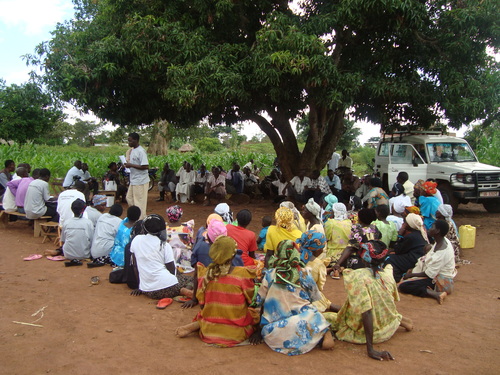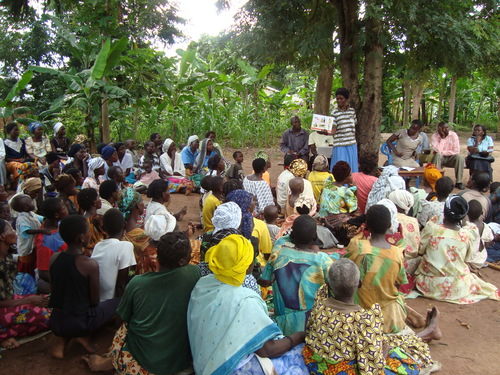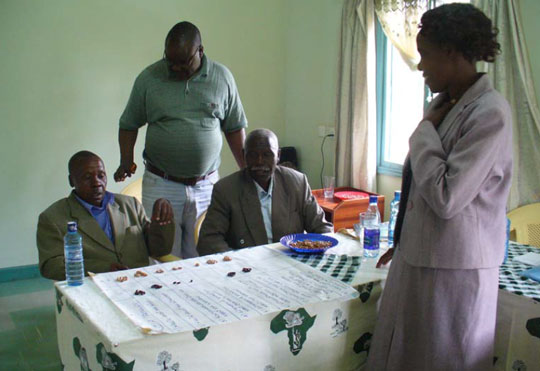Between 13 and 15 October the Open and Collaborative Science in Development Network held its first workshop in Nairobi. The objective of the workshop, organized and funded by the Canadian International Development Research Centre, and supported by the University of Toronto and Kenya iHUB, was to kick-start the construction of a research network to promote 'open science' for the Global South.
This initiative arises in a context where open science has become a buzzword for large foundations such as the Bill and Melinda Gates Foundation and development institutions internationally. In the midst of so much interest, the inevitable question is whether open science can live up to its promises. In this spirit we went to Kenya to learn about and discuss the issue.
STEPS América Latina was privileged to be amongst 14 other institutions whose proposals had been pre-selected (from over 90 applications) by OCSDnet. Participants came from Argentina, Brazil, Costa Rica, Jamaica, Canada, India, Kenya, South Africa, Lebanon, Kyrgyzstan and Thailand. Co-ordinated by Leslie Chan, from the University of Toronto the workshop also included a set of international advisors including Lidia Brito, Hebe Vessuri, Cameron Neylon, Apiwat Ratanawaraha, Matthew Todd and Kaitlin Thaney, representing the Science Lab of the Mozilla Foundation.
If, before the event, a number of elements – the meeting venue, the novelty of the subject, and the excellent background paper – suggested a rewarding and challenging encounter, it rapidly became clear that the event would exceed our expectations. In part this was because the workshop brought together a truly interdisciplinary group of anthropologists, chemists, biologists, lawyers, geographers, ecologists, engineers, experts in social development, forest conservation and sociologists who all shared an interest in the production of open and collaborative knowledge.
In most cases, the participants also had practical experience of the development and use of participatory tools for the collection, management and dissemination of scientific evidence in relation to social or environmental issues. As such, we discussed projects that sought to expand access to scientific databases on botany, foster public control over the emission of gaseous pollutants in urban areas, study the asymmetries of power in cases of indigenous intellectual property, and support the construction of laboratories of open hardware in order to study water contamination, amongst other examples.
Creating dialogue amongst such a heterogeneous set of disciplines, development issues and geographical situations sometimes proved challenging. Of course, there were several moments “lost in translation” (especially between scientists and the few sociologists who participated in the meeting). And yet, the workshop enabled us to explore a rich variety of definitions and interpretations of what it means to do open science (and open innovation).
We cannot summarize here the different points of view aired within the workshop, and interpretations of the event. But if it is interesting to note that it became clear, during the three days, that the notion of open science is intertwined with the collaborative and iconoclastic spirit of the communities of open software and open hardware (along with the hacker and maker movements), the history of grassroots innovation movements, the experiences of Science Shops in Europe and North America and, closer to Latin America, the tradition of participatory action research. All these movements not only share some history with open science, but they also help to form a central aspect of its definition: the search for the democratization of knowledge.
A second issue highlighted during the discussions in Nairobi is the importance of information technology tools for data collection, visualization and communication for the practice of open science. Incorporating these tools is a challenge and a necessity in order to establish ways to collaborate that are open and accessible to the largest number of participants possible.
In the context of increasing interest and discussion of the potential and uses of open science to address major development challenges – for example in research initiatives for orphan diseases – an analysis of the history, diversity and uses of open science practices is more than welcome. It’s also likely that reflection on the notion of open science and citizen participation in the production of knowledge allows us to shed some light on other current topics of innovation and development, as in the cases of research into innovation for social inclusion, and of the tensions between public research and policies for the private commercialization of knowledge.
Of course, there are still more questions than answers. For example: Is it possible to use methodologies of open science for research on issues that are neglected or rejected by dominant institutions of science and technology? In what ways can citizen participation contribute to the collection and validation of evidence on climate change and/or biodiversity loss? In what ways might mechanisms of participatory design and innovation accelerate the development of technologies for social inclusion?
It is difficult to know even if experimentation with forms of open science will be able to help address the growing problems of access and democratization of knowledge about the challenges of inclusive and sustainable development. The OCSDnet initiative certainly contributes to broaden the discussion, and connect the different visions, methods and tools in different regions of the global South. For now, it has given us an excellent reason to investigate the issue, and try to understand different experiences of open and collaborative knowledge production in Argentina and the region.
Find our more about STEPS America Latina
Media coverage of the most recent seminar in the STEPS America Latina’s series: Los nuevos senderos que se abren, Pagina 12
By Mariano Fressoli, STEPS America Latina
Thursday 30 October 2014
Wednesday 29 October 2014
Call for abstracts: Critical Perspectives on the Financialisation of Nature
A Call for Abstracts has been issued for a workshop in March 2015 on the financialisation of nature.
 |
| Dollar Butterfly: icosahedral (Flickr) |
The workshop, aimed at doctoral and early-career researchers, is entitled Critical Perspectives on the Financialisation of Nature – Theory, Politics and Practice. It will be hosted by the the Sussex-based Centre for Global Political Economy and the STEPS Centre.
It will be a 1.5 day intensive workshop bringing together doctoral and early career researchers to discuss, theorise and critically reflect on the practical and political implications of the commodification, marketisation and financialisation of nature.
The workshop will take place at Sussex University on 19th-20th March 2015, and the deadline for abstracts is 5 December 2014.
Full details
Carbon markets in China, fishery bycatch offsetting in Canada, catastrophe bonds in the US, weather derivatives in Ethiopia, betting on species extinction such as Norwegian sharks…
These are just a few examples of the commodification, marketisation and financialisation of nature. In what ways can we best make sense of these developments? What practical, political and theoretical innovations will allow us to better understand them, engage with them and contest them?
We invite participants from any discipline to a 1.5 day intensive workshop bringing together doctoral and early career researchers to discuss, theorise and critically reflect on the practical and political implications of the commodification, marketisation and financialisation of nature. Papers should focus on questions including (but not limited to):
- What are the challenges, contradictions and limits that arise from the creation of these new forms of market-based environmental products and services?
- What are the new materialities and commodities of nature that are created through these novel forms of governance?
- How do these processes change the way we relate to nature, govern nature, live in nature and indeed are governed by nature?
- How does the marketisation or financialisation of nature relate to other forms of accumulation and the wider political economy?
- What kinds of (new) power relations are (re)produced through the making of environmental markets, and what social and environmental justice issues are brought to light or develop in response to these (neoliberal?) phenomena?
Papers
Participants will be required to submit full papers in advance of the workshop and are expected to read each other's work beforehand to enable in-depth engagement with one another's arguments. The sessions will be chaired by academics working in the field who will also provide feedback on papers. Moreover, the workshop will bring together activists and academics for a panel discussion, reflecting on the interlinkages between activism and research on the financialisation of nature.
Timeline and practical arrangements
Please send abstracts of up to 300 words to FoNconference2015@sussex.ac.uk by December 5th, 2014. Successful applicants will be informed before December 31st. Full papers are expected by February 15th, 2015.
Registration is free and food will be provided. We have some funding for accommodation and travel for a limited number of doctoral researchers. Details about applying for this funding will be sent out once abstracts have been selected.
Tuesday 28 October 2014
Business for peace?
 It is difficult to avoid being swept up in the current tide of optimism about Africa and resource development. For once, Africa is not only portrayed by outsiders as a continent of poor people suffering and fighting over civil wars and dependent on good will and aid.
It is difficult to avoid being swept up in the current tide of optimism about Africa and resource development. For once, Africa is not only portrayed by outsiders as a continent of poor people suffering and fighting over civil wars and dependent on good will and aid.So let us focus on resource extraction. The storyline is that Africa is broadening the new frontiers of resource development, shifting the geo-strategic energy and mineral map of the world – from sizeable new finds of off-shore oil and gas in East and West Africa, to iron ore reserves in Sierra Leone, Liberia, Congo and Central Africa.
The story goes on to say that a significant proportion of these new resource developments are in contested areas, in regions with a history of conflict.
Optimism – but what has changed?
While not disputing these new developments, the problem with this new narrative is its lack of historical depth. What has really changed? Is it about intensity and volume of revenues? Are these new investments increasingly reaching into so-called fragile countries and in particular remote areas? And perhaps more importantly, are resource developments happening in response to increasing demand, or is this a resource boom and a situation of over-supply? One participant in a recent meeting I attended at Chatham House suggested that the reason why the Kenyan government is racing so urgently to develop the Turkana oil reserves is precisely because they fear the discovery of cheaper new oil reserves elsewhere.
The answers to this set of questions would enable us to properly understand the extent to which the situation has really changed.
This resource boom narrative is now often associated with an optimistic approach that attempts to criticize or transcend the 'resource curse' story. So how beneficial are natural resources for development and peacebuilding? The problem is that experts are struggling to find good examples. The Indonesia-Aceh peace process or the South Sudan 'well planned but badly implemented' process are often referred to as good examples, but with limited enthusiasm.
'Business for peace'
It is not surprising that the potential for business to play a role in peacebuilding, and the conditions under which this can happen, is becoming a key policy debate – given the so-called resource boom and its focus on 'fragile states'. The fact that resource extractive businesses are the first type of business to get involved in post-conflict (if not conflict) situations is also used as another justification to think about their potential role.
The slogan 'business for peace' raises a few eyebrows, questioning whether businesses could do anything more than corporate social responsibility. In fact, as another delegate at the Chatham House meeting mentioned, sticking to the 'do no harm' rule would already be a considerable advance.
The point here is not to be overly critical about business, but rather to question the expectations and responsibilities put upon 'business for peace' narratives.
Conflict sensitivity is not a realistic option for businesses as, very much like donors, they are political actors. Their business operation forces them to align with one or other of the parties in the conflict. Business cannot truly be perceived, or act as, an honest independent broker. Although one should encourage any moves towards peacebuilding, the narrative 'business for peace' may be harmful in hiding the responsibilities of governments (and potentially donors) to work for redistribution and social cohesion.
Jeremy Allouche is a Research Fellow at IDS and has recently begun working on a new project, Large development investments and local peacebuilding in Africa: Building and sustaining peace at the margins.
Photo: Sudanese Oil Workers by ENOUGH Project on Flickr (by-nc-nd)
And the winners are… The Phiri Award Innovators of 2014
Last week, the first ever five winners of the Phiri Award were announced. All five illustrate the persistence and determination so typical of innovators. As Phiri Award Trustee, John Wilson, explains:
"The Phiri Award Trust believes that it's crucial that we learn from farmer innovators and other innovators in the food chain as we strive to find sustainable and healthy ways of producing and processing food. During this first year's process to find and select innovative farmers there was some muddle between who is a good farmer and who is an innovative farmer. An innovative farmer is someone who has tried out and developed new ways of doing things. (S)he has not simply adopted practices from others".
All those nominated this year are men who came from only three of the country's provinces. The Trust is committed to changing this next year. Nominations from around the country, and particularly of women and younger farmers or those involved in the food chain are welcomed. Get in touch by email: phiriaward@gmail.com.
Anyway, I thought Zimbabweland readers would like to hear about the winners. The short profiles below have been provided by John Wilson, based on research by Mutizwa Mukute.
Faiseni Pedzi:
61 year Faiseni Pedzi has been a smallholder farmer most of his life. For a brief period in his 20s he worked at a sugar estate in the Lowveld. This stint gave him ideas, which he has used to develop a sophisticated water-harvesting set-up on his 3-hectare farm.
VaPedzi farms in Chivi district in natural region 5. Water is obviously critical in such a dry part of Zimbabwe. Early in his farming years he dug four one-metre deep contours on his gently sloping land as the basis of his water-harvesting system. These turned out to be not enough to catch all the water and so he has added trenches at either end of the contour ditches.
Over the years VaPedzi has developed an intricate system to use and spread water through his farm. There are also times he has to release excess water into the nearby river. He needs this versatile system because of the variability in rainy seasons. His system is based on 'valves' that he has especially designed to manage his water, depending on whether they are tight, loose or removed.
VaPedzi intercrops his annual rainy season crops and is able to supplement them with water during dry spells in the rainy season, which are common in region 5. He then under sows his summer crops with winter crops that also benefit from the harvested water. He grows reeds and Vetiver grass on the banks of the ditches and other fodder grasses for fattening cattle for sale. Fishponds are an important part of the system, originally introduced because 'my wife loves eating fish'. His farm is a fine example of agricultural biodiversity and integrated farming based on a sophisticated water harvesting system.
Paguel Takura
Paguel Takura is a farmer who likes to experiment and try things out. He lives in Chikukwa on the border with Mozambique, a higher rainfall part of Zimbabwe. He started his small farm of less than a hectare in 2008 and had a disastrous first year because moles ate the bulk of his sweet potatoes and banana suckers.
Undaunted and using his traditional knowledge for trapping field mice, he began the process of designing an effective mole trap. He tried different containers in which to trap the moles – first bark, then bamboo, then 750ml cooking oil bottles – before hitting on a 250ml Vaseline bottle which doesn't allow the mole to turn around. He has also tried various baits and now favours an indigenous plant that he had observed moles liking. He puts the bottle and bait into a mole tunnel with a sprung stick and in 2011 alone he captured 39 moles.
He now works with others in his community to share and spread his mole trap and has plans to sell the traps.
Wilson Sithole
In 1977 Wilson Sithole's father gave him 2 hectares of land. At that stage he was working in town. During this time he built a house and experimented with water-harvesting ditches, having noticed lots of run-off from his land in the high rainfall area of Rusitu in eastern Zimbabwe. Unfortunately, most of his 2 hectares was unfarmable because it was covered with rocks. This, however, didn't daunt VaSithole.
He knew that with heat and water you can crack and break rocks up. He brought in 7 truckloads of firewood from a nearby timber estate and gradually broke up all the rocks on his farm and turned them into contour bunds, combined with ditches. After 20 years he had 20 bunds and ditches. In between the bunds he has planted bananas, pineapples and citrus trees. For bananas, his harvest averages out at 480kg per month.
Now he is working with other farmers in his area as part of the TSIME programme to find innovative ways to improve farming.
William Gezana
In 2000 Cyclone Eline wreaked havoc on William Gezana's 3-hectare farm in Bumba, Chimanimani. Five of his neighbours died and the cyclone swept away vegetation, houses and animal kraals. The cyclone also caused serious erosion, which undermined the recharging of the stream that William and his neighbors had used for irrigation.
VaGezana, as seems to be the case with many innovator farmers, did not let the enormity of what he had to do to rehabilitate his land dispirit him. Above all, Cyclone Eline taught him the critical importance of water harvesting and so he began laying small rock ridges across his land to catch run off water. He also noticed that during Cyclone Eline, it was the bare areas that suffered most. This led him to plant a range of different species in order to ensure ground cover. The Mukute (Waterberry) has played a significant part in his plans, as has the use of compost.
In a decade VaGezana turned his devastated watershed farm into a productive haven with a diversity of crops. In the process he has recharged the water table and the stream runs again. He taps water from the stream via individually designed and dug irrigation canals. Over 40 farmers have learnt from the integrated farming creativity of William Gezana, using his approach to watershed management in particular.
Bouwas Mawara
Apart from working in town from 1970 to 76, 68-year old Bouwas Mawara has been a small-scale farmer all his life. However, it was only in 1980 that he began innovating, inspired by the liberation struggle, which had given people the 'courage to try things out and confront and challenge the way things are done'.
Living in Mazvihwa, a very dry part of Zimbabwe in Zvishavane District, he knew the importance of water. His first challenge to the normal way of doing things was to dig dead-level contours 1 to 3 metres deep and 2 metres wide; as opposed to the 1 in 200 diversion drains that are normally called contour ditches. These deep ditches have enabled him to harvest huge amounts of water. Furthermore, within the contours he has made small dams in which he farms fish. Occasionally in Mazvihwa there is excess water and he has designed a complex interconnected system using clay pipes that allows him to remove excess water into pits.
As a result of all this water harvesting, VaMawara is able to grow winter crops every dry season, despite living in such a dry part of the country. He even had excess water in the droughts of 1992 and 2008.
On his own initiative, Bouwas Mawara set up Hupenyu Ivhu (Soil is Life) Farmer Innovators' group in 1989. Through this group he has shared his innovative water-harvesting system and farming practices with many farmers in Mazvihwa.
For more information on farmer innovation from around the world, check out the Prolinnova site at http://www.prolinnova.net/. Beyond these five, lots more inspiration there! While formal science and technology is undoubtedly essential for successful agriculture, local innovation from the grassroots is vital too, and is especially powerful when combined with more conventional approaches (as is the case in all domains – see http://steps-centre.org/project/grassroots/). I hope that the Phiri Award will encourage scientists in government, the universities and the CGIAR to go and visit the winners, and discover new innovations. If you look, they are everywhere: innovation is what farming is about.
The post was written by Ian Scoones and appeared on Zimbabweland
"The Phiri Award Trust believes that it's crucial that we learn from farmer innovators and other innovators in the food chain as we strive to find sustainable and healthy ways of producing and processing food. During this first year's process to find and select innovative farmers there was some muddle between who is a good farmer and who is an innovative farmer. An innovative farmer is someone who has tried out and developed new ways of doing things. (S)he has not simply adopted practices from others".
All those nominated this year are men who came from only three of the country's provinces. The Trust is committed to changing this next year. Nominations from around the country, and particularly of women and younger farmers or those involved in the food chain are welcomed. Get in touch by email: phiriaward@gmail.com.
Anyway, I thought Zimbabweland readers would like to hear about the winners. The short profiles below have been provided by John Wilson, based on research by Mutizwa Mukute.
Faiseni Pedzi:
61 year Faiseni Pedzi has been a smallholder farmer most of his life. For a brief period in his 20s he worked at a sugar estate in the Lowveld. This stint gave him ideas, which he has used to develop a sophisticated water-harvesting set-up on his 3-hectare farm.
VaPedzi farms in Chivi district in natural region 5. Water is obviously critical in such a dry part of Zimbabwe. Early in his farming years he dug four one-metre deep contours on his gently sloping land as the basis of his water-harvesting system. These turned out to be not enough to catch all the water and so he has added trenches at either end of the contour ditches.
Over the years VaPedzi has developed an intricate system to use and spread water through his farm. There are also times he has to release excess water into the nearby river. He needs this versatile system because of the variability in rainy seasons. His system is based on 'valves' that he has especially designed to manage his water, depending on whether they are tight, loose or removed.
VaPedzi intercrops his annual rainy season crops and is able to supplement them with water during dry spells in the rainy season, which are common in region 5. He then under sows his summer crops with winter crops that also benefit from the harvested water. He grows reeds and Vetiver grass on the banks of the ditches and other fodder grasses for fattening cattle for sale. Fishponds are an important part of the system, originally introduced because 'my wife loves eating fish'. His farm is a fine example of agricultural biodiversity and integrated farming based on a sophisticated water harvesting system.
Paguel Takura
Paguel Takura is a farmer who likes to experiment and try things out. He lives in Chikukwa on the border with Mozambique, a higher rainfall part of Zimbabwe. He started his small farm of less than a hectare in 2008 and had a disastrous first year because moles ate the bulk of his sweet potatoes and banana suckers.
Undaunted and using his traditional knowledge for trapping field mice, he began the process of designing an effective mole trap. He tried different containers in which to trap the moles – first bark, then bamboo, then 750ml cooking oil bottles – before hitting on a 250ml Vaseline bottle which doesn't allow the mole to turn around. He has also tried various baits and now favours an indigenous plant that he had observed moles liking. He puts the bottle and bait into a mole tunnel with a sprung stick and in 2011 alone he captured 39 moles.
He now works with others in his community to share and spread his mole trap and has plans to sell the traps.
Wilson Sithole
In 1977 Wilson Sithole's father gave him 2 hectares of land. At that stage he was working in town. During this time he built a house and experimented with water-harvesting ditches, having noticed lots of run-off from his land in the high rainfall area of Rusitu in eastern Zimbabwe. Unfortunately, most of his 2 hectares was unfarmable because it was covered with rocks. This, however, didn't daunt VaSithole.
He knew that with heat and water you can crack and break rocks up. He brought in 7 truckloads of firewood from a nearby timber estate and gradually broke up all the rocks on his farm and turned them into contour bunds, combined with ditches. After 20 years he had 20 bunds and ditches. In between the bunds he has planted bananas, pineapples and citrus trees. For bananas, his harvest averages out at 480kg per month.
Now he is working with other farmers in his area as part of the TSIME programme to find innovative ways to improve farming.
William Gezana
In 2000 Cyclone Eline wreaked havoc on William Gezana's 3-hectare farm in Bumba, Chimanimani. Five of his neighbours died and the cyclone swept away vegetation, houses and animal kraals. The cyclone also caused serious erosion, which undermined the recharging of the stream that William and his neighbors had used for irrigation.
VaGezana, as seems to be the case with many innovator farmers, did not let the enormity of what he had to do to rehabilitate his land dispirit him. Above all, Cyclone Eline taught him the critical importance of water harvesting and so he began laying small rock ridges across his land to catch run off water. He also noticed that during Cyclone Eline, it was the bare areas that suffered most. This led him to plant a range of different species in order to ensure ground cover. The Mukute (Waterberry) has played a significant part in his plans, as has the use of compost.
In a decade VaGezana turned his devastated watershed farm into a productive haven with a diversity of crops. In the process he has recharged the water table and the stream runs again. He taps water from the stream via individually designed and dug irrigation canals. Over 40 farmers have learnt from the integrated farming creativity of William Gezana, using his approach to watershed management in particular.
Bouwas Mawara
Apart from working in town from 1970 to 76, 68-year old Bouwas Mawara has been a small-scale farmer all his life. However, it was only in 1980 that he began innovating, inspired by the liberation struggle, which had given people the 'courage to try things out and confront and challenge the way things are done'.
Living in Mazvihwa, a very dry part of Zimbabwe in Zvishavane District, he knew the importance of water. His first challenge to the normal way of doing things was to dig dead-level contours 1 to 3 metres deep and 2 metres wide; as opposed to the 1 in 200 diversion drains that are normally called contour ditches. These deep ditches have enabled him to harvest huge amounts of water. Furthermore, within the contours he has made small dams in which he farms fish. Occasionally in Mazvihwa there is excess water and he has designed a complex interconnected system using clay pipes that allows him to remove excess water into pits.
As a result of all this water harvesting, VaMawara is able to grow winter crops every dry season, despite living in such a dry part of the country. He even had excess water in the droughts of 1992 and 2008.
On his own initiative, Bouwas Mawara set up Hupenyu Ivhu (Soil is Life) Farmer Innovators' group in 1989. Through this group he has shared his innovative water-harvesting system and farming practices with many farmers in Mazvihwa.
For more information on farmer innovation from around the world, check out the Prolinnova site at http://www.prolinnova.net/. Beyond these five, lots more inspiration there! While formal science and technology is undoubtedly essential for successful agriculture, local innovation from the grassroots is vital too, and is especially powerful when combined with more conventional approaches (as is the case in all domains – see http://steps-centre.org/project/grassroots/). I hope that the Phiri Award will encourage scientists in government, the universities and the CGIAR to go and visit the winners, and discover new innovations. If you look, they are everywhere: innovation is what farming is about.
The post was written by Ian Scoones and appeared on Zimbabweland
Friday 24 October 2014
Training health workers in management skills bears fruit
The Challenge
Every day, health service leaders face challenges like working with limited resources while delivering results, managing change, and keeping staff motivated. Decentralisation adds to these challenges, as many health workers have both clinical and managerial responsibilities.
However, little attention is paid to leadership and management skills during their health training.
Communities, donors, local politicians and opinion leaders are demanding accountability and results, which is achievable with simple leadership and management skills.
Our Intervention
In partnership with the districts, who select the candidates, the Makerere University School of Public Health is training health workers in three areas: planning and management of health services, improving management of logistics and improving management of labor and newborn care.
A six-month distance health services management certificate course, targeting district and health facility managers, caters for the first two thematic areas, the focus for this article. In the first phase, 30 health service delivery personnel were drawn from the three study districts (10 from each), and another 30 are attending the second phase of training. The results have been tremendous, with beneficiaries already registering significant improvements back at their work places.
Initial Success
Stephen Otukor, a clinical officer in Pallisa district, said that the financial management skills he acquired during the training are invaluable.
Before the training, spending and finances were not streamlined. Now all his staff know how his clinic's financial resources are used.
By the end of the study, each of the three districts will have had 30 key personnel trained in health services management.
By Kakaire Ayub Kirunda, FHS Uganda Policy Influence and Research Uptake Officer
[Editor's note: This article is the first in a series of updates from the FHS Uganda team that were also compiled in their recent Showcase.]
Every day, health service leaders face challenges like working with limited resources while delivering results, managing change, and keeping staff motivated. Decentralisation adds to these challenges, as many health workers have both clinical and managerial responsibilities.
However, little attention is paid to leadership and management skills during their health training.
Communities, donors, local politicians and opinion leaders are demanding accountability and results, which is achievable with simple leadership and management skills.
Our Intervention
In partnership with the districts, who select the candidates, the Makerere University School of Public Health is training health workers in three areas: planning and management of health services, improving management of logistics and improving management of labor and newborn care.
A six-month distance health services management certificate course, targeting district and health facility managers, caters for the first two thematic areas, the focus for this article. In the first phase, 30 health service delivery personnel were drawn from the three study districts (10 from each), and another 30 are attending the second phase of training. The results have been tremendous, with beneficiaries already registering significant improvements back at their work places.
Initial Success
Stephen Otukor, a clinical officer in Pallisa district, said that the financial management skills he acquired during the training are invaluable.
Before the training, spending and finances were not streamlined. Now all his staff know how his clinic's financial resources are used.
"The other good thing is that when we collect the data nowadays, we analyse it, and we utilize it," adds Stephen. "This has helped us in decision making. For instance, if we plot a graph and find problems, we trace the root causes of why. We then find solutions to the challenges."For Edith Bogere, a senior nursing officer with Kamuli district, turning support supervision into a blame game and police-like interrogation had failed to solve a long-standing problem. But, while still on the course, Edith decided to employ her new skills by suggesting the involvement of the in-charge of the health centre and the staff to find solutions.
"The in-charge gave us her views, and one of them was to change a midwife that was there to another health facility and get her another one or two. And the district health management team respected her opinion. We have since seen deliveries increasing in this facility, even the OPD attendance is improving. When you compare the HMIS report 105 of Bupadhengo now and those before, you see a marked improvement. This is simply because we were able to change our approach to supervision and problem solving."And in the case of Anek Santurinah, a midwife in Pallisa, time management was a problem. "Things like phone calls and visitors who came unnecessarily would take my time. I would sometimes attend to these visitors and ignore clients. But this changed after the training."
By the end of the study, each of the three districts will have had 30 key personnel trained in health services management.
By Kakaire Ayub Kirunda, FHS Uganda Policy Influence and Research Uptake Officer
[Editor's note: This article is the first in a series of updates from the FHS Uganda team that were also compiled in their recent Showcase.]
Thursday 23 October 2014
Journal of Peasant Studies new special issue: critical perspectives on Food Sovereignty
A new special issue on ‘Critical perspectives on food sovereignty’ from the Journal of Peasant Studies has been released, with free articles available for a limited period. The guest editors are Marc Edelman, James C. Scott, Amita Baviskar, Saturnino M. Borras Jr., Deniz Kandiyoti, Eric Holt-Gimenez, Tony Weis and Wendy Wolford.
The issue is volume 2 in a series on Global Agrarian Transformations (Volume 1 is also still accessible for free from the Taylor and Francis website).
As JPS’s contribution to the ongoing food sovereignty debate, the journal is also making available for free for a limited time three commentary articles:
Related articles
The issue is volume 2 in a series on Global Agrarian Transformations (Volume 1 is also still accessible for free from the Taylor and Francis website).
As JPS’s contribution to the ongoing food sovereignty debate, the journal is also making available for free for a limited time three commentary articles:
- A comment on Henry Bernstein's way with peasants, and food sovereignty Philip McMichael
- Can there be food sovereignty here? Tania Murray Li
- The debate on food sovereignty theory: agrarian capitalism, dispossession and agroecology Kees Jansen
Related articles
- Food Sovereignty: a critical dialogue – event in January 2014
- Missing politics and food sovereignty by Ian Scoones, 27 January 2014 (Future Agricultures blog)
- Food sovereignty: a growing activist and intellectual movement by Ruth Hall, 27 January 2014 (PLAAS blog)
Wednesday 22 October 2014
Minimising delays for maternal health seeking in Uganda through saving schemes
The Challenge
When Mrs X (real name withheld) went to her local health centre in one of our intervention districts for a final check-up just one month before her expected due date, she never anticipated what the midwife told her. She was told to make plans to deliver at the health centre or a general hospital because there was a likelihood of her delivery being complicated.
Mrs X had an unusually large baby and needed to deliver in a health facility where caesarean section could easily be offered in time if the need arose. Sadly Mrs X had not saved for the anticipated expenses in form of transport fares, upkeep and the surgery. By the time Mrs X went into labour, her family could hardly raise the transport fare and by the time her husband got the money, a traditional birth attendant had been called in and was failing to help. Mrs X and the baby were lost a few metres from the hospital!
Without any kind of savings in the house to cater for transport Mrs X's family delayed reaching care. The family of Mrs X is not in isolation. There are many more like it.
Our Intervention
Households and individual community members are being educated and encouraged to join or start financial social networks, like saving groups, which offer financial protection. In addition to the business funds, the networks are advised to have a separate fund to cater for maternal and newborn health needs. Members can access these funds to cater for emergency transport to and from the health facility for pregnant women, mothers and newborns. The fund is also meant to provide funds to cater for birth items. Saving groups are similarly encouraged to enter into partnership with transporters.
At inception of the study in 2013, 816 existing groups of all manner and 795 transporters (boda boda drivers) were oriented on the new initiative.
Initial Success
Twambagane Saving Group is one of the groups that has been established in Kamuli district as a result of the orientation and training. With 34 members — 26 women and 8 men — the leader Godfrey Kisubi, who is also a CHW, says membership is closed. His strategy is to encourage groups with manageable numbers that only open up to more members after gaining experience.
Group member Miriam Kisakye is very proud and happy to be part of the initiative. "When the labour started we did not have readily available funds for transport to hospital but our savings in the group came in handy. Let those who have not started such groups act immediately because they are very beneficial," says Miriam who had given birth just two weeks prior to our visit.
There is good news in Pallisa as well, as Betty Opolot, the leader of Puti Puti Central Saving Group explains:
By Kakaire Ayub Kirunda, FHS Uganda Policy Influence and Research Uptake Officer
[Editor's note: This article is the first in a series of updates from the FHS Uganda team that were also compiled in their recent Showcase.]
When Mrs X (real name withheld) went to her local health centre in one of our intervention districts for a final check-up just one month before her expected due date, she never anticipated what the midwife told her. She was told to make plans to deliver at the health centre or a general hospital because there was a likelihood of her delivery being complicated.
Mrs X had an unusually large baby and needed to deliver in a health facility where caesarean section could easily be offered in time if the need arose. Sadly Mrs X had not saved for the anticipated expenses in form of transport fares, upkeep and the surgery. By the time Mrs X went into labour, her family could hardly raise the transport fare and by the time her husband got the money, a traditional birth attendant had been called in and was failing to help. Mrs X and the baby were lost a few metres from the hospital!
Without any kind of savings in the house to cater for transport Mrs X's family delayed reaching care. The family of Mrs X is not in isolation. There are many more like it.
Our Intervention
Households and individual community members are being educated and encouraged to join or start financial social networks, like saving groups, which offer financial protection. In addition to the business funds, the networks are advised to have a separate fund to cater for maternal and newborn health needs. Members can access these funds to cater for emergency transport to and from the health facility for pregnant women, mothers and newborns. The fund is also meant to provide funds to cater for birth items. Saving groups are similarly encouraged to enter into partnership with transporters.
At inception of the study in 2013, 816 existing groups of all manner and 795 transporters (boda boda drivers) were oriented on the new initiative.
Initial Success
Twambagane Saving Group is one of the groups that has been established in Kamuli district as a result of the orientation and training. With 34 members — 26 women and 8 men — the leader Godfrey Kisubi, who is also a CHW, says membership is closed. His strategy is to encourage groups with manageable numbers that only open up to more members after gaining experience.
Group member Miriam Kisakye is very proud and happy to be part of the initiative. "When the labour started we did not have readily available funds for transport to hospital but our savings in the group came in handy. Let those who have not started such groups act immediately because they are very beneficial," says Miriam who had given birth just two weeks prior to our visit.
There is good news in Pallisa as well, as Betty Opolot, the leader of Puti Puti Central Saving Group explains:
"I attended training organized by MANIFEST. After the training, we organized the women and talked to them about the issues related to maternal and newborns and the reasons why we need to save money specifically for maternal and newborn emergencies. 21 women managed to join the group. The saving group started this year (2014) and so far we have saved 500,000 Uganda shillings [. So far one woman has accessed the funds to cater for her transport needs to the hospital."If this momentum is not lost, it is believed that the cases of Mrs. X will be greatly reduced. As at end of August 2014, a total of 1260 groups had an MCH (maternal and child health) fund.
By Kakaire Ayub Kirunda, FHS Uganda Policy Influence and Research Uptake Officer
[Editor's note: This article is the first in a series of updates from the FHS Uganda team that were also compiled in their recent Showcase.]
Melissa Leach on Ebola & inequality – lecture text & audio
Some materials are now available from the recent Sussex Development Lecture on Equality, Sustainability, Security: Interlaced challenges in a global development era by former STEPS Director Melissa Leach. The text is available to download below as a PDF, and you can listen to Melissa's lecture online, courtesy of the Institute of Development Studies.
In the lecture, Melissa uses Ebola as a lens to look at how inequalities, unsustainability and insecurity can interact, enhanced by misguided interventions, to render people and places deeply vulnerable. Addressing these interactions must become central to a renewed vision of development for all.
Ebola: difficult questions for development blogpost by Ian Scoones, 13 October 2014
Our resources on Ebola and other animal-to-human diseases
In the lecture, Melissa uses Ebola as a lens to look at how inequalities, unsustainability and insecurity can interact, enhanced by misguided interventions, to render people and places deeply vulnerable. Addressing these interactions must become central to a renewed vision of development for all.
- Listen: Melissa Leach Sussex Development Lecture Autumn 2014 (Mixcloud website)
- Download the text of the lecture (PDF)
Ebola: difficult questions for development blogpost by Ian Scoones, 13 October 2014
Our resources on Ebola and other animal-to-human diseases
Tuesday 21 October 2014
Community health workers encourage women in Uganda to seek skilled care early in pregnancy
The challenge
Deciding to seek care from a skilled health worker by a woman at the time of delivery is highly encouraged in order to improve health outcomes for both mother and baby. When a woman delivers under skilled care, it is easier to detect and attend to any emergences that arise. However in Uganda, 42 per cent of the estimated 1.2 million women who conceive every year do not deliver under skilled care. Some of the drivers of this sad state of affairs include: poor understanding of complications and risk factors in pregnancy and of when emergency medical interventions are necessary; previous unfortunate experiences of health care services; and acceptance of maternal death as something normal in many communities.
Our Intervention
Still under the community mobilisation and sensitisation component of the study, around 1,691 community health workers (CHWs, also known as village health teams or VHTs), were trained across the three study districts of Kamuli, Pallisa and Kibuku. The training focused on early detection of emergencies, birth preparedness and care for mothers who just delivered and their newborns. During the visits, CHWs provide households with information needed to ensure mothers have a safe delivery and remain healthy with their babies. Two home visits happen during pregnancy and two after delivery.
Initial Success
Ms Grace Asio is a mother of five with her youngest child delivered in early 2014. A mother of five, Grace has conceived seven times since getting married, but lost two pregnancies. She attributes that loss to a failure to appreciate the danger signs and to seek medical care in time.
"On both occasions I bled to near death and would get to hospital late. But all this happened because I did not know that bleeding was a danger sign. But now I can at least tell what the danger signs are during pregnancy. Upon detecting any I quickly tell my husband and we find ways of going to the health centre as fast as possible."
Mr Francis Kedi is the CHW for Okisiran central village in Akisim sub-county of Pallisa district, where Grace resides. Grace has nothing but praise for him. According to Francis, it was not easy "to get into some homes initially because the men thought we were going in to use their families as bait for some personal economic gains."
He adds: "We persisted and explained that what we were doing was for their good and many came on board save for a few perennial drunkards."
Beaming with pride, Francis further intimates that he is increasingly seeing the women he has visited seeking care in time whenever they suspect a problem with the pregnancy, and opting to deliver from health facilities. Francis has visited 65 homes with pregnant women in the last year.
And the outcomes are not any different from Grace's.
A total of 35,108 home visits had been made by the end of August 2014 across the three districts.The home visits by the CHWs who are always armed with flipbooks and demonstration mama kits are enabling women and families prepare better for birth and make informed timely decisions.
By Kakaire Ayub Kirunda, FHS Uganda Policy Influence and Research Uptake Officer
[Editor's note: This article is the first in a series of updates from the FHS Uganda team that were also compiled in their recent Showcase.]
Deciding to seek care from a skilled health worker by a woman at the time of delivery is highly encouraged in order to improve health outcomes for both mother and baby. When a woman delivers under skilled care, it is easier to detect and attend to any emergences that arise. However in Uganda, 42 per cent of the estimated 1.2 million women who conceive every year do not deliver under skilled care. Some of the drivers of this sad state of affairs include: poor understanding of complications and risk factors in pregnancy and of when emergency medical interventions are necessary; previous unfortunate experiences of health care services; and acceptance of maternal death as something normal in many communities.
Our Intervention
Still under the community mobilisation and sensitisation component of the study, around 1,691 community health workers (CHWs, also known as village health teams or VHTs), were trained across the three study districts of Kamuli, Pallisa and Kibuku. The training focused on early detection of emergencies, birth preparedness and care for mothers who just delivered and their newborns. During the visits, CHWs provide households with information needed to ensure mothers have a safe delivery and remain healthy with their babies. Two home visits happen during pregnancy and two after delivery.
Initial Success
Ms Grace Asio is a mother of five with her youngest child delivered in early 2014. A mother of five, Grace has conceived seven times since getting married, but lost two pregnancies. She attributes that loss to a failure to appreciate the danger signs and to seek medical care in time.
"On both occasions I bled to near death and would get to hospital late. But all this happened because I did not know that bleeding was a danger sign. But now I can at least tell what the danger signs are during pregnancy. Upon detecting any I quickly tell my husband and we find ways of going to the health centre as fast as possible."
Mr Francis Kedi is the CHW for Okisiran central village in Akisim sub-county of Pallisa district, where Grace resides. Grace has nothing but praise for him. According to Francis, it was not easy "to get into some homes initially because the men thought we were going in to use their families as bait for some personal economic gains."
He adds: "We persisted and explained that what we were doing was for their good and many came on board save for a few perennial drunkards."
Beaming with pride, Francis further intimates that he is increasingly seeing the women he has visited seeking care in time whenever they suspect a problem with the pregnancy, and opting to deliver from health facilities. Francis has visited 65 homes with pregnant women in the last year.
And the outcomes are not any different from Grace's.
A total of 35,108 home visits had been made by the end of August 2014 across the three districts.The home visits by the CHWs who are always armed with flipbooks and demonstration mama kits are enabling women and families prepare better for birth and make informed timely decisions.
By Kakaire Ayub Kirunda, FHS Uganda Policy Influence and Research Uptake Officer
[Editor's note: This article is the first in a series of updates from the FHS Uganda team that were also compiled in their recent Showcase.]
Tackling negative social cultural norms in Uganda through community dialogues and radio
The Challenge
Having knowledge of obstetric danger signs and embracing good birth preparedness practices could enhance maternal and newborn health outcomes. For example, a woman, working with her family, can choose her preferred birth location; choose her preferred birth attendant and make advance arrangements with that provider; make advance arrangements for transport to the skilled care site; obtain basic safe birth supplies; and save or arrange alternative funds for costs of skilled and emergency care.
However, in many Ugandan households, especially in rural areas, it is taboo to make these preparations. As a result, by the time of delivery, many are stuck in a reactive mode, which has sometimes led to death of either the mother or newborn, and sometimes both.
Our Intervention
Through the use of communications and media advocacy, the intervention study is tackling social and cultural issues that affect maternal and newborn health negatively. We are using village-level dialogues (once every three months) and radio talk shows (monthly) as well as spot messages (daily). The dialogues and talk shows offer a platform for discussing these issues and rally community suggestions and participation in addressing them. This community involvement promotes ownership and sustainability of behavioral changes. The dialogues are also expected to provide peer influence in favour of healthy maternal and newborn practices. And as convenors of the dialogues, village health teams (VHTs) have shared vital knowledge that is slowly changing the negative attitudes towards birth preparedness.
Initial Success
During the dialogues, women and men shared sad memories of maternal and newborn illness and death, underlining the grim reality of the situation. They also discussed good and bad practices and made commitments to abandon negative practices and therefore improve maternal and newborn health.
"I resolve to stop putting cow dung and other dangerous things on the cord of newborns. After today's talk I realise why my baby's cord took that long to heal. I urge fellow women to join a new me," said Ms Nabirye at a dialogue in Kamuli to thunderous applause from fellow women.
Monitoring data shows that, while only 17 per cent of sampled women who had just given birth treated cords with nothing but the appropriate saline water in mid-2013, that percentage had shot to 56% in mid-2014.
Mr Francis Kedi, a CHW in Pallisa says he has observed that more families are now appreciating delivery under skilled care, a view backed by monitoring data. In mid-2013, deliveries in health facilities in the three districts stood at 66%. As of May 2014, that
number had jumped to 84 per cent.
As at the end of August 2014, a total of 73,429 persons had attended the meetings. And if one of the goals of dialogue is to find common ground and find better solutions, then this is starting to manifest itself in the context of maternal and newborn health in the districts of Kamuli, Pallisa and Kibuku.
By Kakaire Ayub Kirunda, FHS Uganda Policy Influence and Research Uptake Officer
[Editor's note: This article is the first in a series of updates from the FHS Uganda team that were also compiled in their recent Showcase.]
Having knowledge of obstetric danger signs and embracing good birth preparedness practices could enhance maternal and newborn health outcomes. For example, a woman, working with her family, can choose her preferred birth location; choose her preferred birth attendant and make advance arrangements with that provider; make advance arrangements for transport to the skilled care site; obtain basic safe birth supplies; and save or arrange alternative funds for costs of skilled and emergency care.
However, in many Ugandan households, especially in rural areas, it is taboo to make these preparations. As a result, by the time of delivery, many are stuck in a reactive mode, which has sometimes led to death of either the mother or newborn, and sometimes both.
Our Intervention
Through the use of communications and media advocacy, the intervention study is tackling social and cultural issues that affect maternal and newborn health negatively. We are using village-level dialogues (once every three months) and radio talk shows (monthly) as well as spot messages (daily). The dialogues and talk shows offer a platform for discussing these issues and rally community suggestions and participation in addressing them. This community involvement promotes ownership and sustainability of behavioral changes. The dialogues are also expected to provide peer influence in favour of healthy maternal and newborn practices. And as convenors of the dialogues, village health teams (VHTs) have shared vital knowledge that is slowly changing the negative attitudes towards birth preparedness.
Initial Success
During the dialogues, women and men shared sad memories of maternal and newborn illness and death, underlining the grim reality of the situation. They also discussed good and bad practices and made commitments to abandon negative practices and therefore improve maternal and newborn health.
"I resolve to stop putting cow dung and other dangerous things on the cord of newborns. After today's talk I realise why my baby's cord took that long to heal. I urge fellow women to join a new me," said Ms Nabirye at a dialogue in Kamuli to thunderous applause from fellow women.
Monitoring data shows that, while only 17 per cent of sampled women who had just given birth treated cords with nothing but the appropriate saline water in mid-2013, that percentage had shot to 56% in mid-2014.
Mr Francis Kedi, a CHW in Pallisa says he has observed that more families are now appreciating delivery under skilled care, a view backed by monitoring data. In mid-2013, deliveries in health facilities in the three districts stood at 66%. As of May 2014, that
number had jumped to 84 per cent.
As at the end of August 2014, a total of 73,429 persons had attended the meetings. And if one of the goals of dialogue is to find common ground and find better solutions, then this is starting to manifest itself in the context of maternal and newborn health in the districts of Kamuli, Pallisa and Kibuku.
By Kakaire Ayub Kirunda, FHS Uganda Policy Influence and Research Uptake Officer
[Editor's note: This article is the first in a series of updates from the FHS Uganda team that were also compiled in their recent Showcase.]
Monday 20 October 2014
Food sovereignty: a contested concept
Emerging out of two major conferences and with a background reading list of more than 90 papers, a special issue of the Journal of Peasant Studies has just emerged on 'critical perspectives on food sovereignty'. This is free to view for a limited period (here: http://www.tandfonline.com/r/fjps-41-6 – click to articles via this link if you don't have a subscription), and contains a number of important papers and commentaries by both academics and activists, and many hybrids. It is an important moment, both for the food sovereignty movement and for the debate around it. For far too long there has been an absence of sustained critical and engaged debate about the meanings and implications of food sovereignty. These papers discuss, among other things, the origins of the concept, its connection to other food justice movements, its relation to rights discourses, the roles of markets and states and the challenges of implementation. It demonstrates a maturing of the movement, and a growing willingness to debate from a position of confidence and strength.
The most visible representation of the food sovereignty movement is the peasant movement, La Via Campesina. This has grown through combining diverse campaigns for changes in the global agri-food system. Some claim that it is the world's largest social movement. 'Food sovereignty', is a term, as Marc Edelman notes in his paper that has a longer genealogy but has become very effectively popularised. This is an argument for peasant autonomy, local food systems, fairer more environmentally-sound, agroecological production and trade and much more besides. As a vision and political programme it is one to which many would subscribe.
For a while I have been intrigued to find out where the food sovereignty debate had got to, what political strategies were emerging and whether, in different and diverse contexts, the ideals were in fact realisable. I attended one of the conferences early this year in the Hague. Elizabeth Mpofu, a Zimbabwean farmer from Shashe resettlement area near Mashava and now the General Coordinator of La Via Campesina and a leader of the movement, opened the proceedings with a passionate rallying call.
What are my reflections on the debate? In many ways I remain rather confused as to what food sovereignty is, and how it is to be translated into a political struggle. The concept has evolved, and the movement has adopted many different angles as more and more elements have been incorporated. These included the move from a focus on small-scale production and markets to concerns with gender, indigenous peoples, environment, workers, consumers, migrants, trade relations and more.
Through accreting issues and agendas, the movement thus offers an all-encompassing vision where nothing is left out it seems. This helps build linkages between different areas of activism, but it also makes it very difficult to get a handle on what the core issues are, and where to focus intellectual and political energies. This is made more challenging by the lack of clarity over the focus of the key concept – sovereignty. There is much focus on 'the local', but this may not be sovereign without addressing the role of the state, or indeed the relationships between states in international trade and global politics. A populist appeal to locality may miss the importance of defining the arenas for political action that necessarily impinge on what happens in local settings.
It is clearly intensely political issue, part of an assertive political project, but it often lacks a solid political analysis. As many argue in the Journal of Peasant Studies issue, a more thorough-going engagement with critical agrarian studies might help address this gap. Three areas of politics, I felt, are missing.
The first is the politics of peasants. La Via Campesina – the peasant's way – asserts the rights of peasants. But who is the peasantry in the context of a globalising world, with dynamic patterns of differentiation across sites? Classic issues of class formation and differentiation are raised, ones that Henry Bernstein so effectively elaborates in his 'sceptical view' paper for the issue. What is the relationship between the peasantry and workers, or indeed worker-peasants, with one foot in town and another in the countryside? Are petty commodity producers or even emergent commercial farmers part of the peasantry, or separate? What differences of gender, age, race for example cut across these class differences, and what conflicts and tensions arise? These are old questions, but highly pertinent to the formation of the emergent solidarities that must define a movement. Creating an idealised vision of a peasant, seemingly independent of context, makes the political project problematic, as the contradictions and conflicts that arise between and within groups may act to undermine the alliances required for a movement to gain traction.
The second area of missing politics is around the politics of technology and ecology. An important strand of the food sovereignty movement is the advocacy for an agroecological approach to farming. Low external inputs, organic production, rejection of biotechnology and so on are all hallmarks. Yet in the advocacy of agroecology too often there is a resort to an essentialist, technical argument, thus falling into the same trap as the advocates of the technologies that are opposed. As Jack Kloppenberg puts it in his paper in respect of agricultural biotechnology, the argument should be less about the particular technology but instead around the terms of access. An open access approach to research and development may generate a range of productivity-enhancing technologies that improve efficiency and reduce production costs, without being at the behest of large-scale corporations. New technologies are of course essential for improving agriculture. Improving the yield of crops through high-tech genetics or the use of chemical fertilisers and pesticides may be essential, yet seem to be rejected by agroecology fundamentalisms.
The bottom line is that farmers want good prices, and consumers want cheap food. This structural relation between producers is crucial. The current agri-food system involves much distortion of prices, and a distribution of value in corporate-controlled value chains that often benefits agribusinesses and retailers, and neither producers nor consumers. Yet too often local food systems can only produce expensive food for elite markets. Clearly internalising the costs to the environment and to labour of the current agri-food system is essential, and this will doubtless produce shorter commodity chains, more localised production and marketing, better conditions for workers and a more equitable distribution of value, as well as more ecologically-sensitive forms of production. Yet, even with such measures, a diversity of innovative, technological responses will be necessary that should not be limited by a technically narrow definition of agroecology.
The third area is the politics of capital, and in particular the relationships between capital and the peasantry. Again, a very old debate. Peasants, however they are defined, are never disengaged from the historical processes of capitalist development. Indeed they are mutually constituted by such processes. The debate is not therefore how to disengage, but how to negotiate the terms of incorporation. There are many examples of adverse incorporation, where poor, marginalised farmers are disadvantaged. But the solution is not to go back to earlier forms of production and market relationship, but to organise for a better deal. Re-embedding markets in social contexts, following Karl Polanyi, is essential if a more democratic control of the food system is to be realised, and this means a political struggle around the terms of trade, the rejection of monopolistic market behaviours, and the opening up of markets to a wider range of players. In many ways, this is an advocacy for a better functioning capitalism without the distortions of corporate concentration, not its rejection outright. This means developing a more strategic engagement with capital around the terms of incorporation and the relationships between markets and societal values, much as the fair trade, organic certification and other movements have done.
The progressive ambitions and utopian ideals of food sovereignty are clearly evident, and ones that many can easily subscribe to. You only have to visit Elizabeth Mpofu and her colleagues on Shashe farm to get a sense of the vision. But how to translate this into a political programme and strategic advocacy around which clear solidarities and alliances can build is less evident. Perhaps with a tighter political economic analysis of the nature of the problem, always necessarily contextualised by history and place, then a more targeted, more effective approach might emerge. I am inspired by the passion and vision of the movement participants and their academic allies, but I am perhaps more sceptical about the practicalities of how, in any setting that I know of, such a vision might be realised in practice, including in Shashe (a question asked by Tania Li). This is of course not a reason to reject trying, but it also suggests the need to think harder about both political possibilities and strategies, and be less dogmatic about approaches, technologies and economic arrangements for more sustainable, people-centred agriculture than sometimes the agroecology and food sovereignty advocates allow.
This blog draws from an earlier reflection on the ISS conference published by Future Agricultures
The post was written by Ian Scoones and appeared on Zimbabweland
The most visible representation of the food sovereignty movement is the peasant movement, La Via Campesina. This has grown through combining diverse campaigns for changes in the global agri-food system. Some claim that it is the world's largest social movement. 'Food sovereignty', is a term, as Marc Edelman notes in his paper that has a longer genealogy but has become very effectively popularised. This is an argument for peasant autonomy, local food systems, fairer more environmentally-sound, agroecological production and trade and much more besides. As a vision and political programme it is one to which many would subscribe.
For a while I have been intrigued to find out where the food sovereignty debate had got to, what political strategies were emerging and whether, in different and diverse contexts, the ideals were in fact realisable. I attended one of the conferences early this year in the Hague. Elizabeth Mpofu, a Zimbabwean farmer from Shashe resettlement area near Mashava and now the General Coordinator of La Via Campesina and a leader of the movement, opened the proceedings with a passionate rallying call.
What are my reflections on the debate? In many ways I remain rather confused as to what food sovereignty is, and how it is to be translated into a political struggle. The concept has evolved, and the movement has adopted many different angles as more and more elements have been incorporated. These included the move from a focus on small-scale production and markets to concerns with gender, indigenous peoples, environment, workers, consumers, migrants, trade relations and more.
Through accreting issues and agendas, the movement thus offers an all-encompassing vision where nothing is left out it seems. This helps build linkages between different areas of activism, but it also makes it very difficult to get a handle on what the core issues are, and where to focus intellectual and political energies. This is made more challenging by the lack of clarity over the focus of the key concept – sovereignty. There is much focus on 'the local', but this may not be sovereign without addressing the role of the state, or indeed the relationships between states in international trade and global politics. A populist appeal to locality may miss the importance of defining the arenas for political action that necessarily impinge on what happens in local settings.
It is clearly intensely political issue, part of an assertive political project, but it often lacks a solid political analysis. As many argue in the Journal of Peasant Studies issue, a more thorough-going engagement with critical agrarian studies might help address this gap. Three areas of politics, I felt, are missing.
The first is the politics of peasants. La Via Campesina – the peasant's way – asserts the rights of peasants. But who is the peasantry in the context of a globalising world, with dynamic patterns of differentiation across sites? Classic issues of class formation and differentiation are raised, ones that Henry Bernstein so effectively elaborates in his 'sceptical view' paper for the issue. What is the relationship between the peasantry and workers, or indeed worker-peasants, with one foot in town and another in the countryside? Are petty commodity producers or even emergent commercial farmers part of the peasantry, or separate? What differences of gender, age, race for example cut across these class differences, and what conflicts and tensions arise? These are old questions, but highly pertinent to the formation of the emergent solidarities that must define a movement. Creating an idealised vision of a peasant, seemingly independent of context, makes the political project problematic, as the contradictions and conflicts that arise between and within groups may act to undermine the alliances required for a movement to gain traction.
The second area of missing politics is around the politics of technology and ecology. An important strand of the food sovereignty movement is the advocacy for an agroecological approach to farming. Low external inputs, organic production, rejection of biotechnology and so on are all hallmarks. Yet in the advocacy of agroecology too often there is a resort to an essentialist, technical argument, thus falling into the same trap as the advocates of the technologies that are opposed. As Jack Kloppenberg puts it in his paper in respect of agricultural biotechnology, the argument should be less about the particular technology but instead around the terms of access. An open access approach to research and development may generate a range of productivity-enhancing technologies that improve efficiency and reduce production costs, without being at the behest of large-scale corporations. New technologies are of course essential for improving agriculture. Improving the yield of crops through high-tech genetics or the use of chemical fertilisers and pesticides may be essential, yet seem to be rejected by agroecology fundamentalisms.
The bottom line is that farmers want good prices, and consumers want cheap food. This structural relation between producers is crucial. The current agri-food system involves much distortion of prices, and a distribution of value in corporate-controlled value chains that often benefits agribusinesses and retailers, and neither producers nor consumers. Yet too often local food systems can only produce expensive food for elite markets. Clearly internalising the costs to the environment and to labour of the current agri-food system is essential, and this will doubtless produce shorter commodity chains, more localised production and marketing, better conditions for workers and a more equitable distribution of value, as well as more ecologically-sensitive forms of production. Yet, even with such measures, a diversity of innovative, technological responses will be necessary that should not be limited by a technically narrow definition of agroecology.
The third area is the politics of capital, and in particular the relationships between capital and the peasantry. Again, a very old debate. Peasants, however they are defined, are never disengaged from the historical processes of capitalist development. Indeed they are mutually constituted by such processes. The debate is not therefore how to disengage, but how to negotiate the terms of incorporation. There are many examples of adverse incorporation, where poor, marginalised farmers are disadvantaged. But the solution is not to go back to earlier forms of production and market relationship, but to organise for a better deal. Re-embedding markets in social contexts, following Karl Polanyi, is essential if a more democratic control of the food system is to be realised, and this means a political struggle around the terms of trade, the rejection of monopolistic market behaviours, and the opening up of markets to a wider range of players. In many ways, this is an advocacy for a better functioning capitalism without the distortions of corporate concentration, not its rejection outright. This means developing a more strategic engagement with capital around the terms of incorporation and the relationships between markets and societal values, much as the fair trade, organic certification and other movements have done.
The progressive ambitions and utopian ideals of food sovereignty are clearly evident, and ones that many can easily subscribe to. You only have to visit Elizabeth Mpofu and her colleagues on Shashe farm to get a sense of the vision. But how to translate this into a political programme and strategic advocacy around which clear solidarities and alliances can build is less evident. Perhaps with a tighter political economic analysis of the nature of the problem, always necessarily contextualised by history and place, then a more targeted, more effective approach might emerge. I am inspired by the passion and vision of the movement participants and their academic allies, but I am perhaps more sceptical about the practicalities of how, in any setting that I know of, such a vision might be realised in practice, including in Shashe (a question asked by Tania Li). This is of course not a reason to reject trying, but it also suggests the need to think harder about both political possibilities and strategies, and be less dogmatic about approaches, technologies and economic arrangements for more sustainable, people-centred agriculture than sometimes the agroecology and food sovereignty advocates allow.
This blog draws from an earlier reflection on the ISS conference published by Future Agricultures
The post was written by Ian Scoones and appeared on Zimbabweland
Gender equality and Sustainability: STEPS members contribute to new UN Women report
STEPS Centre members have contributed to a major United Nations report that highlights the deep connections between gender equality and sustainable development, as the world moves towards a post-2015 framework.
The World Survey on the role of women in development 2014: Gender equality and sustainable development is the latest in UN Women's flagship series, published every five years. Its conceptualisation was led by Melissa Leach, former STEPS director and now Institute of Development Studies Director; Lyla Mehta, STEPS Centre Water & Sanitation theme convenor; with assistance from Preetha Prabhakaran.
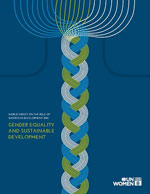 This year’s report highlights the fundamental links between gender equality and pathways to sustainability, and recommends concrete policy actions to move towards an economically, socially and environmentally sustainable future, in which all women and girls, men and boys enjoy their human rights.
This year’s report highlights the fundamental links between gender equality and pathways to sustainability, and recommends concrete policy actions to move towards an economically, socially and environmentally sustainable future, in which all women and girls, men and boys enjoy their human rights.
Pathways and gender
The framing of the report draws centrally on the STEPS Centre's Pathways Approach, outlining a 'gendered pathways approach' which unites the challenges of working for environmental sustainability and gender equality. Melissa Leach has written a STEPS blog explaining the background to this thinking.
The report criticises dominant development models that support particular types of underregulated market-led growth, which rely on unequal power relations between women and men, at the same time as promoting the overexploitation of natural resources and the pollution of climates, land and oceans. Alternative pathways and trajectories, responding to these problems, are suggested in a number of areas such as the green economy, care, food security and investment.
The report also warns against stereotypes of women as ‘sustainability saviours’ and instead calls for approaches which recognise women’s rights, knowledge and values, and ensure their proper role in decision-making.
The report will be presented to the Second Committee of the General Assembly on Monday 20 October, followed by a panel discussion (pdf) about the key issues raised. Panellists will include, among others, Melissa Leach and Hilal Elver (UN Special Rapporteur on the Right to Food).
Find out more
The World Survey on the role of women in development 2014: Gender equality and sustainable development is the latest in UN Women's flagship series, published every five years. Its conceptualisation was led by Melissa Leach, former STEPS director and now Institute of Development Studies Director; Lyla Mehta, STEPS Centre Water & Sanitation theme convenor; with assistance from Preetha Prabhakaran.
 This year’s report highlights the fundamental links between gender equality and pathways to sustainability, and recommends concrete policy actions to move towards an economically, socially and environmentally sustainable future, in which all women and girls, men and boys enjoy their human rights.
This year’s report highlights the fundamental links between gender equality and pathways to sustainability, and recommends concrete policy actions to move towards an economically, socially and environmentally sustainable future, in which all women and girls, men and boys enjoy their human rights.Pathways and gender
The framing of the report draws centrally on the STEPS Centre's Pathways Approach, outlining a 'gendered pathways approach' which unites the challenges of working for environmental sustainability and gender equality. Melissa Leach has written a STEPS blog explaining the background to this thinking.
The report criticises dominant development models that support particular types of underregulated market-led growth, which rely on unequal power relations between women and men, at the same time as promoting the overexploitation of natural resources and the pollution of climates, land and oceans. Alternative pathways and trajectories, responding to these problems, are suggested in a number of areas such as the green economy, care, food security and investment.
The report also warns against stereotypes of women as ‘sustainability saviours’ and instead calls for approaches which recognise women’s rights, knowledge and values, and ensure their proper role in decision-making.
The report will be presented to the Second Committee of the General Assembly on Monday 20 October, followed by a panel discussion (pdf) about the key issues raised. Panellists will include, among others, Melissa Leach and Hilal Elver (UN Special Rapporteur on the Right to Food).
Find out more
- Blog: Why gender equality and sustainable development are inextricably linked by Melissa Leach
- Read the report: World Survey on the Role of Women in Development 2014: Gender Equality and Sustainable Development
- The STEPS Pathways Approach: video and publications
- Post-2015: resources from the STEPS Centre
Why gender equality and sustainable development are inextricably linked
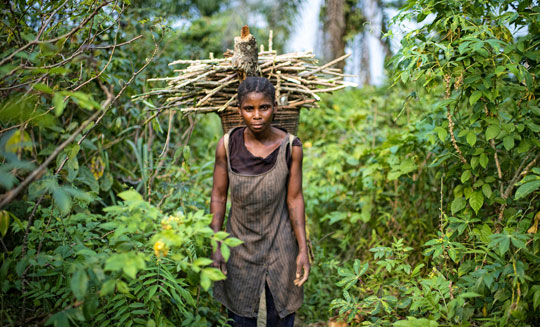 As the world moves towards Sustainable Development Goals for the post-2015 era, there is emerging debate about how target-setting and implementation might integrate across the 17 goals proposed by the Open Working Group (OWG) so that the inextricable links between, say, climate change, water and food are properly addressed. Meanwhile, feminists and others rightly celebrate that goal 5 ('Achieve gender equality and empower all women and girls') survived the fraught, politicised OWG process.
As the world moves towards Sustainable Development Goals for the post-2015 era, there is emerging debate about how target-setting and implementation might integrate across the 17 goals proposed by the Open Working Group (OWG) so that the inextricable links between, say, climate change, water and food are properly addressed. Meanwhile, feminists and others rightly celebrate that goal 5 ('Achieve gender equality and empower all women and girls') survived the fraught, politicised OWG process.But while retaining this as a 'standalone' goal is a victory that may guard against the perils of gender mainstreaming and marginalisation, arguably the integration of this with the implementation of the other SDGs is the most important task of all.
As a major United Nations report launched on 20th October argues, gender equality must be integral to sustainable development. This is the latest in the flagship series of five-yearly World Survey on the Role of Women in Economic Development reports, prepared by UN Women. I had the privilege, together with IDS and STEPS Centre colleagues Lyla Mehta and Preetha Prabhakaran, of leading its conceptualisation. This included authoring the background conceptual framing chapter laying out a 'gendered pathways approach', and working with international feminist scholars to shape contributions in areas where gender-sustainability intersections are biting hard.
Interlocked pathways
The report shows how the effects of unsustainable patterns of development often intensify gender inequalities, as women and girls are disproportionately affected by economic, social and environmental shocks and stresses.
It argues that around many issues – whether work and industrial production, population and reproduction, food and agriculture, or water, sanitation and energy – dominant development pathways have often contributed to both unsustainability and gender inequality. Both are produced by development models that support particular types of under-regulated market-led growth and the persistence of unequal power relations between women and men.
Such pathways rely on and reproduce gender inequalities, for instance by exploiting women's labour and unpaid care work. They also produce environmental problems, as market actors seek and secure profit in ways that rely on the overexploitation of natural resources and the pollution of climates, land and oceans. As troubling intersections of unsustainability and gender inequality threaten or exceed planetary boundaries around climate change, biodiversity and pollution, so shocks, stresses and feedbacks may undermine gendered rights and capabilities even further.
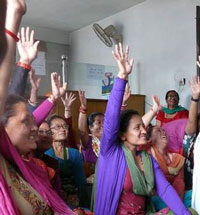 But the reverse is also possible: gender equality and sustainability can powerfully reinforce each other in alternative pathways. Women's knowledge, agency and collective action are often central to these, whether in managing local landscapes, adapting to climate change, producing and accessing food, or securing sustainable water, sanitation and energy services. We see this in examples where women are fully involved in forms of local forest governance that deliver both livelihood and conservation benefits, as Bina Agarwal has traced, and where networks of grass-roots women leaders are working to scale up capacity to reduce vulnerabilities to climate change in their communities.
But the reverse is also possible: gender equality and sustainability can powerfully reinforce each other in alternative pathways. Women's knowledge, agency and collective action are often central to these, whether in managing local landscapes, adapting to climate change, producing and accessing food, or securing sustainable water, sanitation and energy services. We see this in examples where women are fully involved in forms of local forest governance that deliver both livelihood and conservation benefits, as Bina Agarwal has traced, and where networks of grass-roots women leaders are working to scale up capacity to reduce vulnerabilities to climate change in their communities.For pathways to be truly sustainable and advance gender equality and the rights and capabilities of women and girls, those whose lives and well-being are at stake must be involved in leading the way, through community groups, women's organizations and other forms of collective action and engagement – supported by appropriate forms of investment and public services.
Women as 'sustainability saviours'? Beyond stereotypes to a relational view
However, a simple ‘win-win’ relationship between gender equality and sustainability cannot be assumed. Indeed, a policy focus on women can risk casting them as 'sustainability' saviours' in ways that stereotype their roles in relation to the family, the community and the environment. Such responses often add 'environment' to women's already heavy unpaid care and work burdens, without conferring rights, resources and benefits. Power imbalances in gender relations shape whether women's actions and work translate into the realization of their capabilities. And gender is always and everywhere cross-cut by other, intersecting power relations and inequalities, whether around class or ethnicity, age or place.
Hence analysis of interactions, tensions and trade-offs between different dimensions of gender relations and of sustainability is needed, along with attention to the structural foundations of gender discrimination and struggles against this. Recent policy attention to women and girls, from campaigning around the 'girl effect' to debates around the UK's Girl Summit earlier this year, while laudable in many respects, often lacks this relational perspective. Instead, women and girls are treated as individual victims, saviours or development beneficiaries in ways that may entrench stereotypes, while ultimately failing to empower. If goal 5 is to do its vital integrative work for the SDGs and the post-2015 agenda, then attention to gendered power relations, in all their rich, intersecting variety, must remain centre stage.
by Melissa Leach, Director, Institute of Development Studies
Find out more
UN Women: World Survey on the Role of Women in Economic Development 2014
The STEPS Centre's Pathways Approach: video, briefings and book
Pictures:
- Portraits of a woman, Lukolela, Democratic Republic of Congo, by Ollivier Girard (Flickr, cc-by-nc-nd)
- Women from Lumanti (Thankot, Nepal) participate in awareness raising session. Photo: OpenIdeo
New Multicriteria Mapping software launched
 Multicriteria Mapping (MCM), a new software package to aid decision-making by exploring contrasting perspectives on complex issues, has been launched.
Multicriteria Mapping (MCM), a new software package to aid decision-making by exploring contrasting perspectives on complex issues, has been launched.MCM was pioneered by STEPS co-director Andy Stirling as a way of ‘opening up’ technical assessment by systematically ‘mapping’ the practical implications of alternative options, knowledge, framings and values. The new software will make MCM usable for a wider range of users in academia, civil society and industry.
About Multicriteria Mapping
Originally developed to explore debates around GM foods, MCM techniques have been in use since 1997. Recently the MCM project has worked with Brighton based developers DabApps to develop software for a wider range of users in academia, civil society and industry.
MCM focuses as much on ‘opening up’ as on ‘closing down’ a strategy or policy process. With a mix of qualitative and quantitative approaches, it aims to give users and collaborators a clear picture of how and why different perspectives vary on key issues and options – as well as the practical implications for decisions.
The software, backed by a manual, is available as a free trial version for single projects, as well as paid-for versions for collaborative and larger-scale projects.
For more information and to download the software, visit www.multicriteriamapping.com
MCM and STEPS
The STEPS Centre has used and adapted a variety of methods to open up alternative social, technological and environmental pathways to sustainability, including MCM.
STEPS Methods: Multicriteria Mapping
Read a more detailed description of how MCM helps with broadening out academic research or policy appraisal, its benefits and limitations.
Maize project: MCM project method
This 4-page briefing explains how MCM was used in our project on climate change and maize innovation in Kenya to evaluate different perspectives on possible pathways for farmers confronted by droughts and climate change.
For more related material, visit our methods and methodologies website.

Talking Zimbabwe & Land Reform at ASAUK14 this Wednesday
New research from Zimbabwe will be shared at a double panel session at the UK African Studies Association conference this week.
This year's event is at the University of Sussex, and our session is on Wednesday 10 September from 9 to 10.30 and 11 to 12.30. The session has been organised by Gareth James of Edinburgh University, and I am chairing (for full panel & paper details, see below).
Zimbabwe's land reform that unfolded from 2000 has been intensely controversial, and remain so. But 14 years on there is a wider array of research to draw from in order to make more balanced and informed conclusions on outcomes and implications.
The work by me and colleagues, published in the book Zimbabwe's Land Reform: Myths and Realities, showed how some farmers who gained land through the land reform in Masvingo did remarkably well – accumulating, investing and improving production. Others have pointed to the 'tobacco boom' that has brought significant riches to those in the Highveld tobacco areas. Such successes have not universally been the case however. Land in some areas remains poorly utilised, some larger scale farmers have failed to invest, and political elites have captured land but not put it into production.
The panel, 'New narratives and emerging issues in the Zimbabwe land debate', will provide an opportunity to reflect on new research conducted by Zimbabwean and European researchers in the last few years in different parts of the country.
This post was written by Ian Scoones and originally appeared on Zimbabweland
This year's event is at the University of Sussex, and our session is on Wednesday 10 September from 9 to 10.30 and 11 to 12.30. The session has been organised by Gareth James of Edinburgh University, and I am chairing (for full panel & paper details, see below).
Zimbabwe's land reform that unfolded from 2000 has been intensely controversial, and remain so. But 14 years on there is a wider array of research to draw from in order to make more balanced and informed conclusions on outcomes and implications.
The work by me and colleagues, published in the book Zimbabwe's Land Reform: Myths and Realities, showed how some farmers who gained land through the land reform in Masvingo did remarkably well – accumulating, investing and improving production. Others have pointed to the 'tobacco boom' that has brought significant riches to those in the Highveld tobacco areas. Such successes have not universally been the case however. Land in some areas remains poorly utilised, some larger scale farmers have failed to invest, and political elites have captured land but not put it into production.
The panel, 'New narratives and emerging issues in the Zimbabwe land debate', will provide an opportunity to reflect on new research conducted by Zimbabwean and European researchers in the last few years in different parts of the country.
This post was written by Ian Scoones and originally appeared on Zimbabweland
World Food Day 2014: Seven new papers unpick debates on African agriculture and rural development
To mark World Food Day, IIED, ODI and IDS have launched the first seven of 12 new papers addressing agricultural and rural development debates in sub-Saharan Africa.
World Food Day celebrates the anniversary of the UN Food and Agriculture Organization's creation on 16 October 1945, and is a good occasion to reflect on the challenges of achieving food security worldwide. This year’s theme, 'Family Farming: Feeding the world, caring for the earth', was chosen to raise the profile of family farming and smallholder farmers.
There is general agreement that family farming plays important roles in eradicating hunger and poverty, providing food security and nutrition, improving livelihoods, managing natural resources, protecting the environment, and achieving sustainable development. However, the debates around the specific policies and investments needed for this are as heated as ever.
In sub-Saharan Africa in particular, the challenges of feeding a growing and increasingly urbanised population, while increasing household incomes for rural producers, have given rise to fierce debate and contested recommendations.
A new form of Afro-optimism
IIED, the Overseas Development Institute (ODI) and the Institute of Development Studies (IDS) have teamed up to explore these debates by commissioning research with funding from the Department for International Development (DFID) and the International Fund for Agricultural Development (IFAD), and the first seven papers are published today.
The project team wanted to see what has changed since 2001, when influential papers in an issue of Development Policy Review entitled "Rethinking rural development" suggested the power of agriculture to drive development was declining, as more and more people sought jobs in other sectors.
Today, the world is a different place. Agriculture is firmly back on the African development agenda, but the political and institutional environment has changed. Most rural Africans now live and farm in liberalised markets, which most African and international policy forums assume to be the best basis for economic activities.
This shift has been accompanied by changes in the framing and narratives that underpin policy discourse and processes. Mainstream debates on agricultural policy now orbit around notions like opportunity, competition, entrepreneurialism, value chains and public-private partnership, resulting in an enterprise-agrarian variant of Afro-optimism.
Liberalisation, coupled with rising food prices, has also sparked interest among private investors in Africa's agricultural land and commodities. African institutions such as the Comprehensive Africa Agriculture Development Programme (CAADP) seek to help African countries reach a higher path of economic growth through agriculture-led development and boosting agricultural productivity. Donors such as the New Alliance for Food Security and Nutrition are keen to support this vision.
But not everyone is happy with these developments. Those questioning the effectiveness of liberalisation to catalyse sustainable and fair development point out that many big questions remain unanswered.
T.S. Jayne, Ferdinand Meyer and Lulama Ndibongo Traub investigate 'megatrends' such as rising food and energy prices, climate change, urbanisation and demographic transitions that are shaping African economic, political and social landscapes. They discuss how policy choices will influence each of four plausible scenarios for African food systems, and argue that the state can play a major role to engage the public in determining what a 'good society' looks like.
Douglas Gollin asks what type of investment is best for the viability of smallholder systems. He concludes that the implications for development policy are not straightforward, as the priorities vary across and within countries due to the highly heterogeneous nature of the smallholder sector.
Felicity J. Proctor discusses emerging policy implications for economic diversification in rural sub-Saharan Africa. She explores the potential of bringing rural and urban development policies together, ideally within a territorial or regional development framework, to strengthen the market and service linkages between rural and urban areas.
David Booth investigates the scope for reforming African agricultural policy choices. While recognising the difficulties that many countries face in developing the agricultural policies they need to transform their economies, he encourages policymakers to abandon 'pessimistic' political-economy diagnostics. Instead he provides evidence that social and economic reforms can be achieved 'against the odds' when local actors are empowered to pursue a politically smart, entrepreneurial approach.
Henry Bernstein and Carlos Oya distinguish different approaches to markets that affect rural sub-Saharan Africa. They propose a political economy approach as an effective way to grasp the complex social dynamics of 'real markets', the subsequent class differentiation of 'small farmers' and how this affects rural 'livelihood diversification'.
Andrew Dorward and Ephraim Chirwa review the changing paradigms, politics and theories associated with input subsidy programmes. Their paper discusses how such programmes can improve and realise their potential to deliver major benefits to smallholder farmers and wider economies.
Towela Nyirenda-Jere and John Kazembe look at the role of knowledge management and information and communications technologies (ICTs). They conclude that the capacity to collect and analyse locally-relevant data for policymaking is still low and the linkages between ICTs, knowledge management and policymaking are not yet well established.
The remaining papers in this series, which we will publish later this year, will focus on agricultural innovation systems, the social relations of agrarian transitions, rural resource 'grabs', and the future of rural financial services.
by Barbara Adolph and Laura Silici, IIED
This article first appeared on the IIED website.
World Food Day celebrates the anniversary of the UN Food and Agriculture Organization's creation on 16 October 1945, and is a good occasion to reflect on the challenges of achieving food security worldwide. This year’s theme, 'Family Farming: Feeding the world, caring for the earth', was chosen to raise the profile of family farming and smallholder farmers.
There is general agreement that family farming plays important roles in eradicating hunger and poverty, providing food security and nutrition, improving livelihoods, managing natural resources, protecting the environment, and achieving sustainable development. However, the debates around the specific policies and investments needed for this are as heated as ever.
In sub-Saharan Africa in particular, the challenges of feeding a growing and increasingly urbanised population, while increasing household incomes for rural producers, have given rise to fierce debate and contested recommendations.
A new form of Afro-optimism
IIED, the Overseas Development Institute (ODI) and the Institute of Development Studies (IDS) have teamed up to explore these debates by commissioning research with funding from the Department for International Development (DFID) and the International Fund for Agricultural Development (IFAD), and the first seven papers are published today.
The project team wanted to see what has changed since 2001, when influential papers in an issue of Development Policy Review entitled "Rethinking rural development" suggested the power of agriculture to drive development was declining, as more and more people sought jobs in other sectors.
Today, the world is a different place. Agriculture is firmly back on the African development agenda, but the political and institutional environment has changed. Most rural Africans now live and farm in liberalised markets, which most African and international policy forums assume to be the best basis for economic activities.
This shift has been accompanied by changes in the framing and narratives that underpin policy discourse and processes. Mainstream debates on agricultural policy now orbit around notions like opportunity, competition, entrepreneurialism, value chains and public-private partnership, resulting in an enterprise-agrarian variant of Afro-optimism.
Liberalisation, coupled with rising food prices, has also sparked interest among private investors in Africa's agricultural land and commodities. African institutions such as the Comprehensive Africa Agriculture Development Programme (CAADP) seek to help African countries reach a higher path of economic growth through agriculture-led development and boosting agricultural productivity. Donors such as the New Alliance for Food Security and Nutrition are keen to support this vision.
But not everyone is happy with these developments. Those questioning the effectiveness of liberalisation to catalyse sustainable and fair development point out that many big questions remain unanswered.
- Will smallholder farmers drive agricultural growth or will such growth side-line these farmers?
- Will 'farming as a business' contribute to rural poverty, unemployment and migration, or support the growth of the rural non-farm economy? And
- What about agroecology and food sovereignty?
T.S. Jayne, Ferdinand Meyer and Lulama Ndibongo Traub investigate 'megatrends' such as rising food and energy prices, climate change, urbanisation and demographic transitions that are shaping African economic, political and social landscapes. They discuss how policy choices will influence each of four plausible scenarios for African food systems, and argue that the state can play a major role to engage the public in determining what a 'good society' looks like.
Douglas Gollin asks what type of investment is best for the viability of smallholder systems. He concludes that the implications for development policy are not straightforward, as the priorities vary across and within countries due to the highly heterogeneous nature of the smallholder sector.
Felicity J. Proctor discusses emerging policy implications for economic diversification in rural sub-Saharan Africa. She explores the potential of bringing rural and urban development policies together, ideally within a territorial or regional development framework, to strengthen the market and service linkages between rural and urban areas.
David Booth investigates the scope for reforming African agricultural policy choices. While recognising the difficulties that many countries face in developing the agricultural policies they need to transform their economies, he encourages policymakers to abandon 'pessimistic' political-economy diagnostics. Instead he provides evidence that social and economic reforms can be achieved 'against the odds' when local actors are empowered to pursue a politically smart, entrepreneurial approach.
Henry Bernstein and Carlos Oya distinguish different approaches to markets that affect rural sub-Saharan Africa. They propose a political economy approach as an effective way to grasp the complex social dynamics of 'real markets', the subsequent class differentiation of 'small farmers' and how this affects rural 'livelihood diversification'.
Andrew Dorward and Ephraim Chirwa review the changing paradigms, politics and theories associated with input subsidy programmes. Their paper discusses how such programmes can improve and realise their potential to deliver major benefits to smallholder farmers and wider economies.
Towela Nyirenda-Jere and John Kazembe look at the role of knowledge management and information and communications technologies (ICTs). They conclude that the capacity to collect and analyse locally-relevant data for policymaking is still low and the linkages between ICTs, knowledge management and policymaking are not yet well established.
The remaining papers in this series, which we will publish later this year, will focus on agricultural innovation systems, the social relations of agrarian transitions, rural resource 'grabs', and the future of rural financial services.
by Barbara Adolph and Laura Silici, IIED
This article first appeared on the IIED website.
Wednesday 15 October 2014
Research methods for people-centred health systems: Photovoice
In our previous blog post introducing how FHS approached the Third Global Symposium on Health Systems Research, we highlighted the thematic focus of the symposium is 'people-centred health systems'.
FHS has been working for some years to put people first when it comes to health systems, whether it be through understanding how people actually use new technologies, such as in our project on health information seeking behaviour in Bangladesh, or working with communities in Afghanistan to rate and improve their health services through community scorecards.
But putting people at the centre of health systems also means finding different research approaches to studying health systems strengthening. We're profiling a few methods during the symposium. And today's focus is on photovoice.
A bit about photovoice
Photovoice is a visual research methodology through which people can represent, and enhance their community by photographing their daily lives and the lives of those around them. It is a qualitative and participatory research method that aims to capture what occurs when researchers are not necessarily present.
Following a range of trainings – on how to use digital cameras, how to approach a picture subject, and getting people's consent – study participants use the cameras provided to them to capture photographs and moments that are relevant to the research study. These photos are then discussed, often in a group, to highlight particular photos and to explain their particular relevance to the topic at hand. In many cases, these photographs then also serve as a key part of the communication strategy of the research project.
How FHS has employed photovoice
Although this is a relatively new approach for us, The Future Health Systems consortium has already used the photovoice technique in two of our focus countries: Uganda and India.
In Uganda, as part of the FHS young researcher grant, David Musoke worked with select youth in a community in rural Uganda to document issues related to maternal and childhood health in the community. Study participants used the cameras provided to them to capture aspects and situations in their community where youth can contribute to improving maternal health for a period of five months. Monthly meetings were held between the youth and research team to discuss the photos and to identify collectively emerging themes and areas for action. See the Uganda photovoice slideshow below, or download the booklet, to see some of the results.
OK, maybe it sounds obvious. But the problem isn't necessarily that there are no health care facilities for women. While a considerable number of women in Uganda do choose to give birth in their homes, it isn't necessarily because of a lack of facilities.
Despite stories of limited numbers of qualified health workers and the poor attitudes these workers can take towards pregnant women, they manage to serve many women and children.
Pictured here is a pregnant woman who is smiling after having received adequate care at a local health facility.
To reach health facilities and trained health workers, women from this particular village in Central Uganda must travel over 7 kilometres (5 miles). It takes both time and money to travel there, which limits the number of antenatal and post-natal visits expectant and new mothers make.
A common way to get to the health facilities is on a hired motorcycle, known as a bodaboda. These motorcycles are convenient, and they're one of the few means of transportation that can navigate the rugged terrain, but they're not a particularly safe way to transport pregnant women. But there is little choice.
In this picture a mother takes her young child to a health centre for an immunisation.
After walking or taking a bodaboda to get to a facility, many would think that the hard part is over. But getting to a facility is just the first problem an expecting mother might face: often pregnant women must wait several hours for a consultation.
Here, two pregnant women lay on the grass outside the health centre waiting for the health workers to arrive.
There are costs associated with getting to a health facility, but the Ugandan government says that health services provided at government facilities should be free. Apparently the Ugandan government doesn't define 'free' the way the rest of the world does.
Because of limited funding from the government and from international sources, many facilities are forced to charge for basic materials like latex gloves. In cases where women were expecting that they wouldn't need to pay, or who are simply too poor to pay, this can result in death.
In this picture, a woman counts money collected in a local savings group which can assist members when in need particularly pregnant women during time of delivery.
Teenage pregnancy is associated with greater complications for both the mother and child, which can often result in death. But in Uganda, the median age for a mother at first birth is 18.6 years.
Pictured here is a pregnant teenager who is also carrying her first child in her arms.
Although several methods for contraception are available in Uganda, many couples do nothing to space their children. This is partly due to lack of awareness and availability of contraceptive services at many health facilities particularly in rural areas. The country's unmet need for family planning among married women is currently 34%.
In this picture are two siblings who can be mistaken to be twins, which is an indication of lack of use of family planning methods. As the older is only learning how to crawl, the young one is starting to sit.
The Ministry of health has made efforts of increasing male involvement in maternal and child health issues. Indeed, pregnant women who are accompanied by their spouses to public health facilities for antenatal care are attended to first before those who are alone. However, male involvement is still very low.
Here, a pregnant woman not accompanied by their spouse for antenatal care waits to be seen by a health worker at a government health centre.
Women in rural Uganda do a lot of domestic work. This includes cultivation, washing clothes, cooking, fetching water and other household chores. One would imagine that when these women are in their final weeks of pregnancy and soon after delivery, they are relieved of some of these strenuous duties. However, this is not the case in most households.
In this picture is a pregnant woman a few weeks from delivery as she was from collecting water from a distant water source for household use.
Meen dhara, or prawn seed collection, is a traditional way of making a living in the community. But dirty water is becoming more of a problem, especially for women collectors. The dirty water can get inside women, causing uterine infections.
Crab catching is one of the few livelihoods remaining in one community, but it's very strenuous, risky and time-consuming.
'Sometimes you get wounded, causing heavy bleeding... then you have sit quietly, waiting for your body to absorb the shock... then you can start working again.'
This ferry landing (ghat) has been broken for last three months. This is the only way to cross the river. The mainland, where the nearest Public Health Centre is located, is on the other side.
'I am suffering from a chronic disease... Medicines are very costly and not always available here. I have shifted to a rural medical practitioner (RMP) who gave me medicines on credit.'
'The girls in our community often get married at the age of 13 or 14. The girl in the picture gave birth to a low-weight baby at the age of 16. Parents often marry off their daughters at an early age to reduce the number of family members. It's a way of managing resource constraints.'
'I leave my younger child with the older one. I know it is very risky but we have to sustain.'
FHS India photovoice participants meet with the local self-government (panchayat) to discuss health issues highlighted through the photovoice process.
On Thursday, 2 October 2014, FHS invited participants at the Symposium to take pictures with Instagram and Twitter and to tag them with #HSG2014PV, #HSR2014PV or #HSR2014. These were collected via Evenstagram to form our own snapshot of the Symposium for the day.
You can review the photos below or online. Let us know which ones are your favourite and why!
By Jeff Knezovich, FHS Policy Influence and Research Uptake Manager.
FHS has been working for some years to put people first when it comes to health systems, whether it be through understanding how people actually use new technologies, such as in our project on health information seeking behaviour in Bangladesh, or working with communities in Afghanistan to rate and improve their health services through community scorecards.
But putting people at the centre of health systems also means finding different research approaches to studying health systems strengthening. We're profiling a few methods during the symposium. And today's focus is on photovoice.
A bit about photovoice
Photovoice is a visual research methodology through which people can represent, and enhance their community by photographing their daily lives and the lives of those around them. It is a qualitative and participatory research method that aims to capture what occurs when researchers are not necessarily present.
Following a range of trainings – on how to use digital cameras, how to approach a picture subject, and getting people's consent – study participants use the cameras provided to them to capture photographs and moments that are relevant to the research study. These photos are then discussed, often in a group, to highlight particular photos and to explain their particular relevance to the topic at hand. In many cases, these photographs then also serve as a key part of the communication strategy of the research project.
How FHS has employed photovoice
Although this is a relatively new approach for us, The Future Health Systems consortium has already used the photovoice technique in two of our focus countries: Uganda and India.
In Uganda, as part of the FHS young researcher grant, David Musoke worked with select youth in a community in rural Uganda to document issues related to maternal and childhood health in the community. Study participants used the cameras provided to them to capture aspects and situations in their community where youth can contribute to improving maternal health for a period of five months. Monthly meetings were held between the youth and research team to discuss the photos and to identify collectively emerging themes and areas for action. See the Uganda photovoice slideshow below, or download the booklet, to see some of the results.
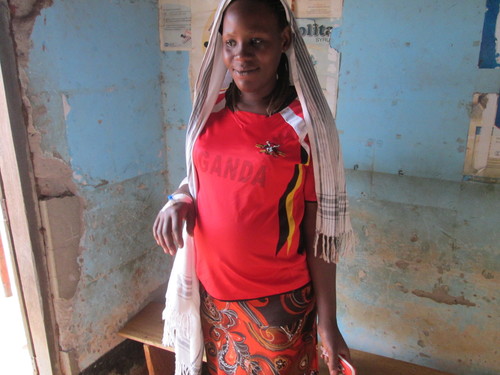 |
| Health facilities in rural areas do exist FHS Uganda Photovoice: EriaMdidde |
Despite stories of limited numbers of qualified health workers and the poor attitudes these workers can take towards pregnant women, they manage to serve many women and children.
Pictured here is a pregnant woman who is smiling after having received adequate care at a local health facility.
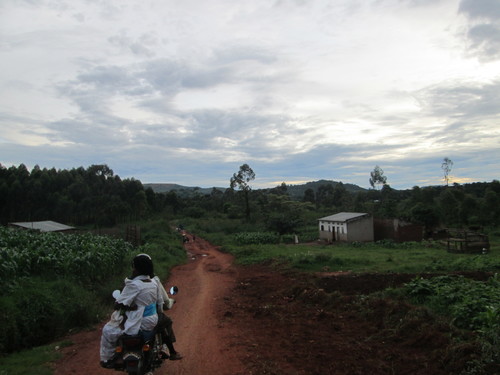 |
| But that doesn't mean they're easy to get to! FHS Uganda Photovoice: Denis Mpiima Mukooza |
A common way to get to the health facilities is on a hired motorcycle, known as a bodaboda. These motorcycles are convenient, and they're one of the few means of transportation that can navigate the rugged terrain, but they're not a particularly safe way to transport pregnant women. But there is little choice.
In this picture a mother takes her young child to a health centre for an immunisation.
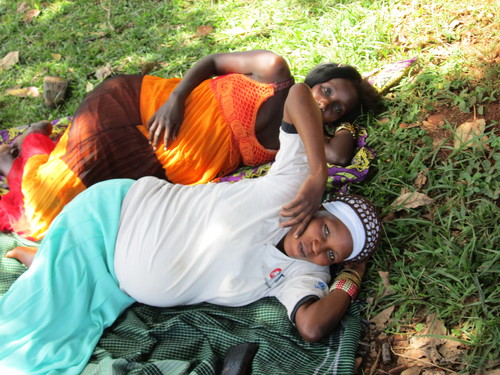 |
| Getting there is half the challenge, getting seen might be just as difficult FHS Uganda Photovoice: John Ssewadda |
Here, two pregnant women lay on the grass outside the health centre waiting for the health workers to arrive.
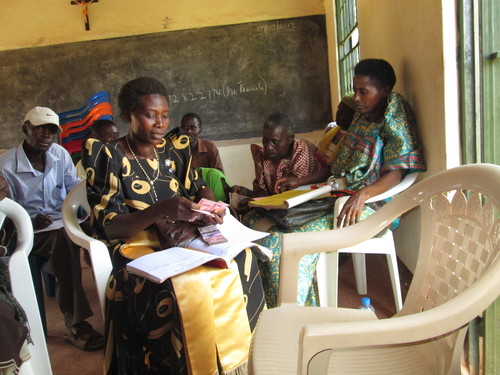 |
| 'Free' doesn't really mean 'free' FHS Uganda Photovoice: Annet Nakayima |
Because of limited funding from the government and from international sources, many facilities are forced to charge for basic materials like latex gloves. In cases where women were expecting that they wouldn't need to pay, or who are simply too poor to pay, this can result in death.
In this picture, a woman counts money collected in a local savings group which can assist members when in need particularly pregnant women during time of delivery.
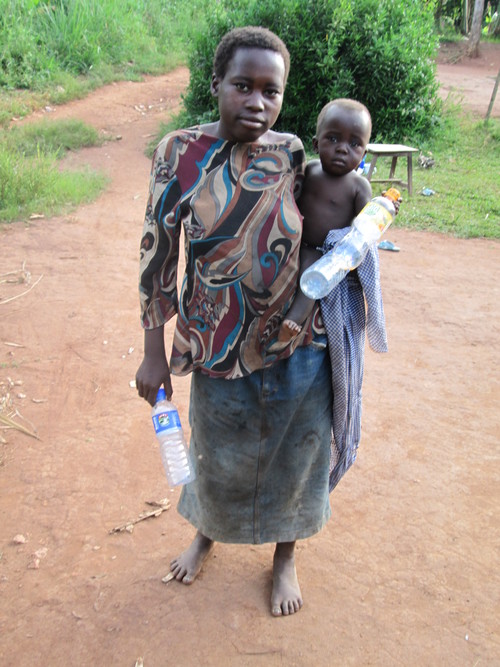 |
| Many don't know about the risks of early pregnancy FHS Uganda Photovoice: Anthony Mpanga |
Pictured here is a pregnant teenager who is also carrying her first child in her arms.
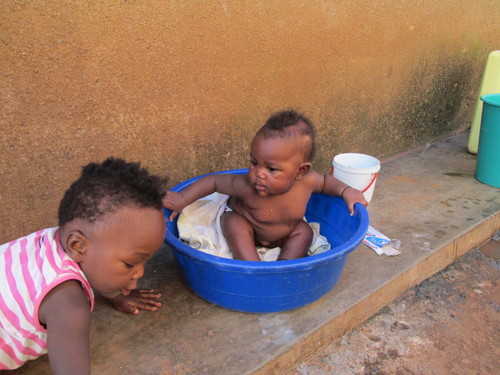 |
| And there is still limited use of contraception FHS Uganda Photovoice: Roger Mubiru |
In this picture are two siblings who can be mistaken to be twins, which is an indication of lack of use of family planning methods. As the older is only learning how to crawl, the young one is starting to sit.
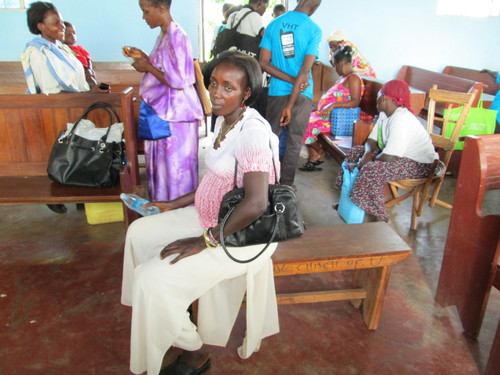 |
| There remains low male involvement FHS Uganda Photovoice: Annet Nakayima |
Here, a pregnant woman not accompanied by their spouse for antenatal care waits to be seen by a health worker at a government health centre.
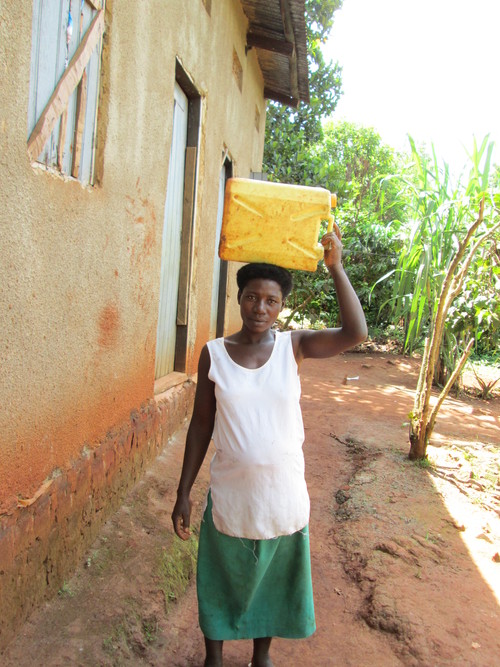 |
| Being pregnant doesn't mean there's relief from household chores FHS Uganda Photovoice: Roger Mubiru |
In this picture is a pregnant woman a few weeks from delivery as she was from collecting water from a distant water source for household use.
In India, researchers worked with women's groups in the Indian Sundarbans of West Bengal to document the interplay between climate, health and resilience there. The focus remained mainly on maternal and newborn health. The participants mainly sought to capture images that explain how a changing climate affects their daily livelihoods, barriers that exist to accessing health services, and ways that locals are adapting to these challenges. The results are available for download in our FHS India photovoice booklet and for viewing in the slideshow below.
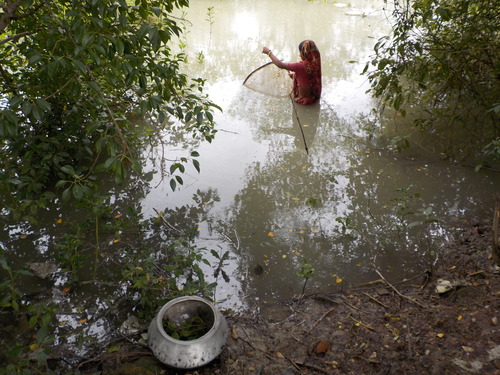 |
| Meen dhara: A costly way to make a living? Photographer: Bandana Haldar, (Binodhpur, Kultali) |
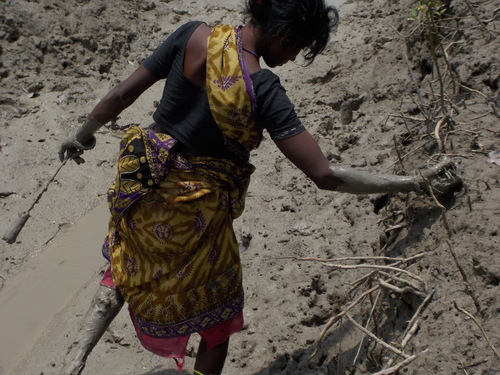 |
| Crab catching Photographer: Parul Bhakta (Satyadaspur, G-Plot) |
'Sometimes you get wounded, causing heavy bleeding... then you have sit quietly, waiting for your body to absorb the shock... then you can start working again.'
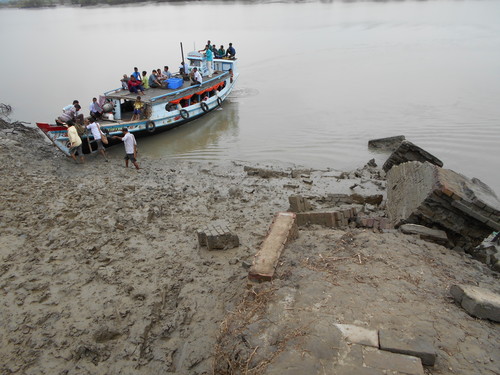 |
| A broken ferry ghat Photographer: Sita Das (Jayasree Colony, G-plot) |
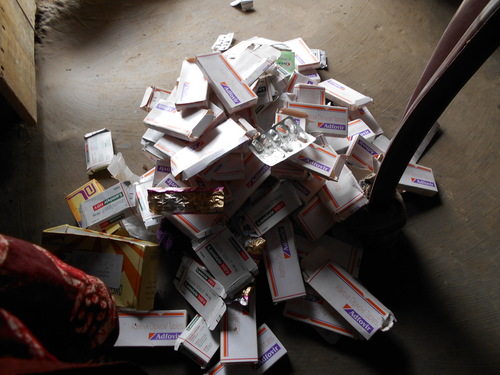 |
| The cost of medicine adds up quickly for those with chronic conditions Photographer: Lakkhana Debnath (Jayasree Colony, G-Plot) |
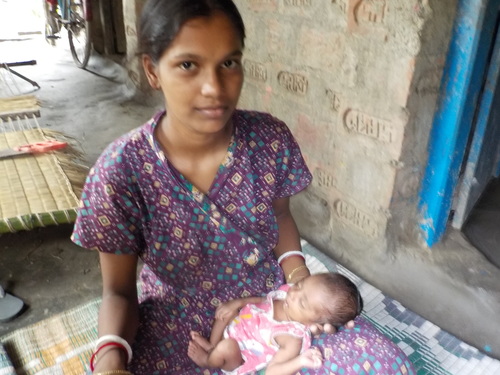 |
| Teenage mother coddles a baby born at a low birth weight Photographer: Sipra Haldar (Binodhpur, Kultali) |
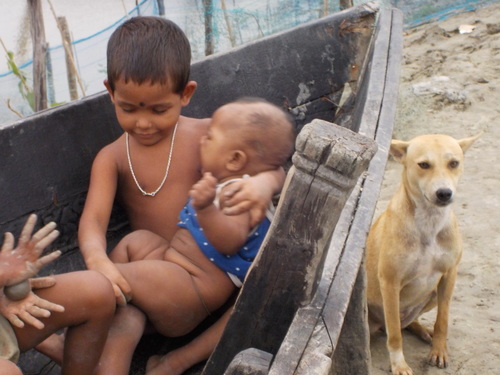 |
| Older children as caretakers Photographer: Bornali Giri (Nogenabad, Kultali) |
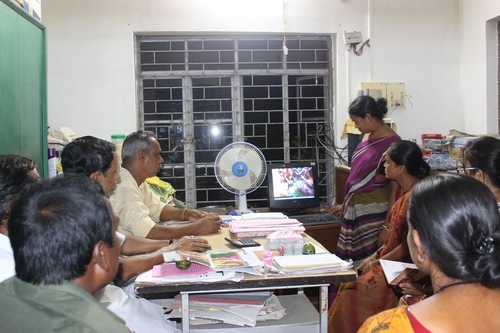 |
| Discussing findings with decision makers |
Giving photovoice a try at HSR2014
On Thursday, 2 October 2014, FHS invited participants at the Symposium to take pictures with Instagram and Twitter and to tag them with #HSG2014PV, #HSR2014PV or #HSR2014. These were collected via Evenstagram to form our own snapshot of the Symposium for the day.
You can review the photos below or online. Let us know which ones are your favourite and why!
By Jeff Knezovich, FHS Policy Influence and Research Uptake Manager.
Subscribe to:
Posts (Atom)



